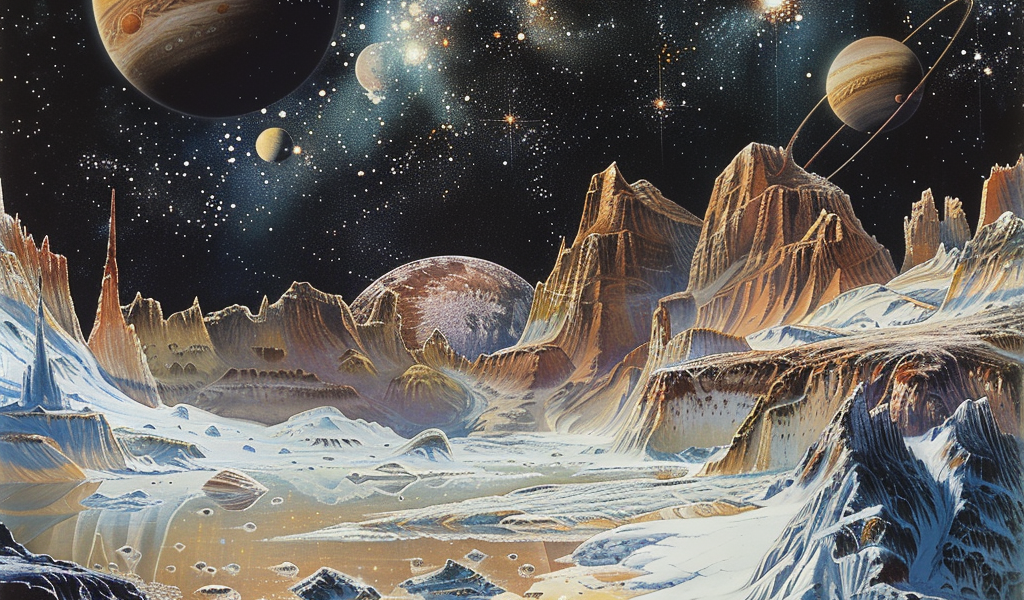The solar system is a vast expanse filled with intriguing celestial bodies, many of which are shrouded in ice. These frozen worlds, with their unique characteristics and potential for harboring life, have captured the attention of scientists and space enthusiasts alike. Here, we explore six remarkable icy bodies that showcase the wonders of our cosmic neighborhood.
1. Europa: Jupiter’s Icy Moon
Europa, one of Jupiter’s most fascinating moons, is covered by a thick layer of ice that conceals a vast, salty ocean beneath its surface. This ocean is believed to be in contact with Europa’s rocky mantle, creating the potential for chemical reactions that could support life. The smooth, icy surface of Europa is crisscrossed with cracks and ridges, suggesting that the ice is dynamic and may be shifting due to the gravitational pull from Jupiter.
2. Enceladus: Saturn’s Geyser Moon
Enceladus, a small moon of Saturn, is renowned for its spectacular geysers that erupt from its south pole, shooting jets of water vapor and ice particles into space. These plumes are a direct indication of the subsurface ocean that exists beneath its icy crust. The discovery of organic molecules in the plumes has sparked interest in the moon as a potential habitat for extraterrestrial life. The Cassini spacecraft provided invaluable data about Enceladus, enhancing our understanding of its icy surface and the ocean below.
3. Triton: Neptune’s Largest Moon
Triton, the largest moon of Neptune, stands out for its unique features, including frozen nitrogen on its surface and geysers that erupt with dark material. These geysers are believed to be caused by the sublimation of nitrogen ice, which creates plumes that shoot into the thin atmosphere. Triton’s retrograde orbit suggests that it may have been captured by Neptune’s gravity, making it a fascinating subject for study. Its icy landscape and potential subsurface ocean make Triton an intriguing candidate for future exploration.
4. Ceres: The Dwarf Planet
Ceres, located in the asteroid belt between Mars and Jupiter, is classified as a dwarf planet and is home to bright spots composed of salt and ice. These spots, observed by NASA’s Dawn mission, are thought to be briny deposits left behind after the evaporation of subsurface brine. Ceres also features a unique landscape with large craters and a possible subsurface ocean, making it a prime target for understanding the building blocks of life in our solar system.
5. Mars: The Red Planet’s Polar Ice Caps
Mars, often referred to as the Red Planet, is known for its polar ice caps, which are made up of water ice and dry ice (frozen carbon dioxide). These ice caps expand and contract with the changing seasons, providing valuable insights into Martian climate patterns. The presence of water ice on Mars is significant for future exploration and potential colonization, as it could serve as a vital resource for astronauts.
6. Pluto: The Distant Ice World
Pluto, once classified as the ninth planet, is now recognized as a dwarf planet and features vast plains of nitrogen ice along with towering mountains made of water ice. The New Horizons mission provided stunning images of Pluto’s surface, revealing a complex and diverse landscape. The interaction between nitrogen ice and the thin atmosphere suggests dynamic processes at work, raising questions about the potential for life in such a distant and frigid environment.
Scientists are increasingly focused on these icy worlds, as the ice covering them may hold vital clues about the possibility of life beyond Earth. Understanding the composition and behavior of the ice on these celestial bodies can offer insights into the conditions that might support life.
NASA has launched numerous missions aimed at studying these frozen realms, including the Galileo mission, which explored Jupiter and its moons, and the New Horizons mission, which provided groundbreaking data about Pluto and the Kuiper Belt. Future missions are planned to delve deeper into these icy worlds, potentially uncovering signs of life and enhancing our knowledge of the solar system.
The exploration of these frozen landscapes not only fuels our curiosity about life beyond our planet but also contributes to our understanding of planetary formation and evolution. As technology advances and new missions are developed, the mysteries of these cosmic ice worlds will continue to unfold.





